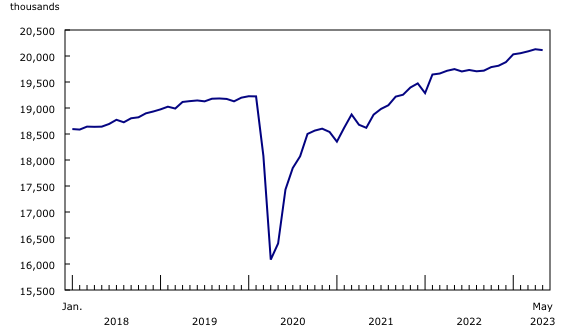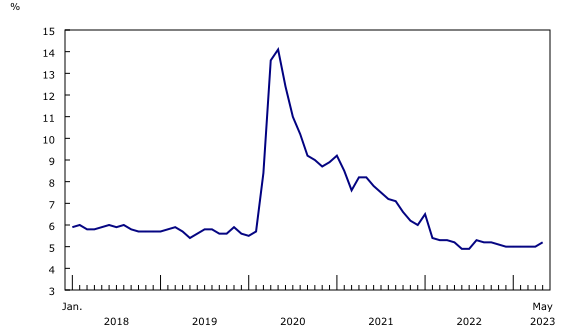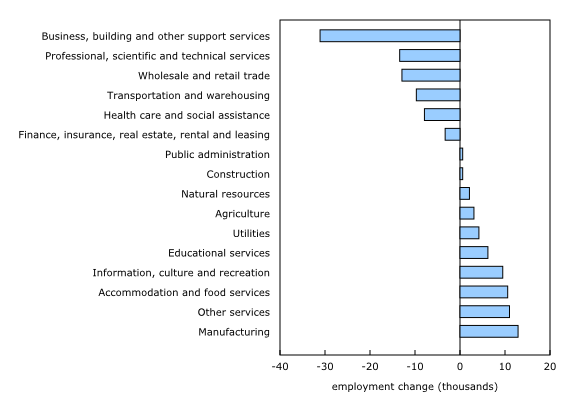Overall employment was little changed in May, as employment fell by 77,000 (-2.8%) for youth aged 15 to 24, and it increased by 63,000 (+0.5%) among people aged 25 to 54.
The unemployment rate rose 0.2 percentage points to 5.2%—the first increase since August 2022.
Employment declined in Ontario (-24,000; -0.3%), Nova Scotia (-5,200; -1.0%), and Newfoundland and Labrador (-4,200; -1.8%) in May 2023, while it increased in Manitoba (+8,200; +1.2%). There was little change in the other provinces.
There were fewer people employed in business, building and other support services (-31,000; -4.4%), as well in professional, scientific and technical services (-13,000; -0.7%). Employment increased in manufacturing (+13,000; +0.7%), “other services” (+11,000; +1.5%) and utilities (+4,200; +2.7%).
Total hours worked fell 0.4% in May, but were up 2.2% on a year-over-year basis.
On a year-over-year basis, average hourly wages rose 5.1% (+$1.61 to $33.25) in May (not seasonally adjusted).
The employment rate of First Nations people living off reserve, aged 25 to 54, was 67.4% in May, down 5.0 percentage points from a year earlier. Among Métis of the same age group, the employment rate was 80.0% in May, down slightly from a year earlier (82.2%) (three-month moving averages).
Employment little changed in May as growth moderates
Overall employment was virtually unchanged in May (-17,000; -0.1%). Employment growth has moderated in recent months and monthly increases averaged 33,000 from February to April. This followed strong employment gains totalling 326,000 from September 2022 to January 2023.
The employment rate—the percentage of people aged 15 and older who are employed—declined by 0.3 percentage points to 62.1% in May. This reflected strong population growth in the month (+83,000) and little change in employment.
The number of employees held steady in the private and public sector, while there was a decline in the number of self-employed workers (-40,000; -1.5%).
Chart 1
Employment little changed in May

Fewer youth aged 15 to 24 employed
Among all youth aged 15 to 24, including students and non-students, employment fell by 77,000 (-2.8%) in May, with declines observed for young women (-43,000; -3.2%) and young men (-35,000; -2.5%). The decline in the month partially offset a net increase of 99,000 recorded from November 2022 to April 2023. On a year-over-year basis, youth employment was little changed in May.
Labour Force Survey (LFS) estimates are seasonally adjusted to remove seasonal patterns in the monthly data. Typically, employment increases for youth in May. The unadjusted increase in youth employment this May was less than usual, resulting in a seasonally-adjusted employment decline.
The youth employment rate was 57.6% in May, down 2.0 percentage points from the recent high of 59.6% reached in March and April, and offsetting a net increase of 1.9 percentage points recorded from September 2022 to April 2023. The youth employment rate in May fell 1.8 percentage points on a year-over-year basis, and was comparable to the pre-COVID-19 pandemic average from 2017 to 2019 (58.2%).
Students see slow start to summer job season
From May to August, the LFS collects labour market information on youths aged 15 to 24 who were attending school full time in March and who intend to return to school full time in the fall. The results for May provide the first indicators of the summer job market, especially for students aged 20 to 24, as many younger students are still in school. Data for June, July and August will provide further insight into the summer job market.
Among returning students, the employment rate for young women (aged 20 to 24) fell from a record high of 69.5% for the month of May in 2022 to 63.8% in May 2023, which was lower than the pre-pandemic rate of 67.7% recorded for this group in May 2019 (not seasonally adjusted).
The employment rate for young male returning students in the same age group in May 2023 was 63.9%, little changed from a year earlier, and comparable to the rate in May 2019 (61.4%).
Core-age employment rises, driven by men
Employment increased by 43,000 among core-aged men (aged 25 to 54) in May, following a gain of 18,000 in April and little variation in February and March. The employment rate for core-aged men ticked up 0.3 percentage points from April to 88.1% in May, and was little changed compared with 12 months earlier.
Employment rose 19,000 for core-aged women in May, following three consecutive months of little change. The employment rate of core-aged women was 81.7% in May, unchanged from the previous month, but down 0.5 percent points from the record high observed in January 2023.
Employment levels were little changed for men and women aged 55 and older in May. The employment rate for men aged 55 and older was down 0.3 percentage points to 40.3% in the month, while it was little changed at 30.9% for women in the same age group.
Unemployment rate rises for the first time in nine months
After holding steady at 5.0% for five consecutive months from December 2022 to April 2023, the unemployment rate rose 0.2 percentage points to 5.2% in May. This was the first monthly increase since August 2022.
The youth unemployment rate was 10.7% in May, up 1.1 percentage points from April, and the highest rate since October 2022 (10.9%). Among people aged 55 and older, the unemployment rate edged up 0.2 percentage points to 4.1% in May, partly offsetting a 0.4 percentage point decline in April. The unemployment rate for those in the core working age (25 to 54) was 4.3% in May, unchanged in the month and on a year-over-year basis.
Among the three largest racialized population groups in Canada, the unemployment rate fell by 0.6 percentage points on a year-over-year basis for South Asian Canadians (5.9%), while it was little changed for Chinese (6.2%) and fell by 1.3 percentage points for Black (7.5%) Canadians (three-month moving averages, not seasonally adjusted).
The participation rate—the proportion of the population who is employed or unemployed—was down 0.1 percentage points to 65.5% in May. This mostly reflected a decline in the participation rate for youth aged 15 to 24, which dropped 1.4 percentage points to 64.5% in May, a rate comparable to that of September 2022 (64.3%).
Chart 2
Unemployment rate ticks up in May

1 in 10 workers had a hybrid work arrangement in May
In May, 10.0% of workers had a hybrid work arrangement—that is, they usually worked partly at home and partly in locations other than home. This was little changed from the proportion recorded in December 2022 (9.6%)—the last time the data were collected—but up 3.7 percentage points compared with May 2022 (population aged 15 to 69, not seasonally adjusted).
As of May 2023, 14.4% of workers worked exclusively at home. This was little changed from December 2022 (15.8%) and down 4.8 percentage points from May 2022 (19.2%). In May 2023, over two in five (41.3%) workers in professional, scientific and technical services usually worked exclusively at home, the most of any industry. However, the proportion was down 9.4 percentage points from 12 months earlier (50.7%).
The proportion of workers who usually either worked exclusively at home or had a hybrid work arrangement was highest in Ontario (27.3%) and Quebec (26.2%). It was lowest in Saskatchewan (14.8%) and Newfoundland and Labrador (14.7%). These differences reflect a number of factors, such as variations in employment composition by industry, depending on the province. For example, professional, scientific and technical services accounted for 10.2% of total employment in Ontario in May, while it accounted for 4.7% of total employment in Newfoundland and Labrador.
Employment down in the services-producing sector, led by business, building and other support services
Employment fell by 40,000 (-0.3%) in the services-producing sector in May, following an upward trend from August 2022 to April 2023.
Employment in business, building and other support services—which includes activities that support the day-to-day operations of organizations, ranging from waste management to administrative services—fell by 31,000 (-4.4%) in May. This brings the cumulative decrease for April and May in the industry to 45,000 (-6.2%), offsetting the increase recorded in March (+31,000; +4.4%).
In professional, scientific and technical services, employment decreased 13,000 (-0.7%) in May, following four months of little change. This was the first monthly decrease for the industry since January 2022.
The number of people working in the “other services” industry—which includes a variety of services such as personal care and repair and maintenance—rose in May (+11,000; +1.5%), following little change in April and offsetting a decrease of 11,000 in March.
In the goods-producing sector, employment rose 23,000 (+0.6%) in May. Following seven months of little change, employment in manufacturing increased by 13,000 (+0.7%) in May. This increase in the month was concentrated in Ontario (+20,000; +2.5%). Nationally, employment in manufacturing was up by 46,000 on a year-over-year basis. Employment in utilities was up in May (+4,200; +2.7%) compared with the previous month.
Chart 3
Employment declines in business, building and other support services in May

Employment falls in Ontario, Nova Scotia, and Newfoundland and Labrador
Employment decreased in Ontario, Nova Scotia and Newfoundland and Labrador in May, while there was an increase in Manitoba. All other provinces recorded little change. For further information on key province and industry level labour market indicators, see “Labour Force Survey in brief: Interactive app.”
In Ontario, employment decreased by 24,000 (-0.3%) in May, following a net increase of 205,000 (+2.7%) from September 2022 to April 2023. The unemployment rate in the province increased 0.6 percentage points to 5.5% in May. Employment held steady in the Toronto census metropolitan area (CMA).
Following two months of little change, employment in Nova Scotia decreased by 5,200 (-1.0%) in May. With fewer Nova Scotians in the labour force, the unemployment rate in the province fell 0.6 percentage points to 5.7%. In the Halifax CMA, both employment and the unemployment rate (4.9%) were little changed (three-month moving averages). Wildfires in areas outside Halifax occurred after the LFS reference week of May 14 to May 20.
There were fewer people employed in Newfoundland and Labrador in May (-4,200; -1.8%), following two consecutive months of little change. The unemployment rate held steady at 10.2% as fewer people participated in the labour market.
Manitoba saw employment growth of 8,200 (+1.2%) in May, the third increase in four months. The unemployment rate in the province was unchanged at 4.8%, while the labour force participation rate rose 0.6 percentage points to 67.4%. In the Winnipeg CMA, the unemployment rate (4.9%) held steady (three-month moving averages).
Alberta and British Columbia—both of which experienced wildfires during the LFS reference week—saw little overall employment change in May. The unemployment rate held steady at 5.7% in Alberta and 5.0% in British Columbia.
In Quebec, employment was little changed for the fourth consecutive month in May, and the unemployment rate (4.0%) remained just above the record low of 3.9% reached in January 2023 and November 2022. In the CMA of Montréal, employment increased by 19,000 (+0.8%), and the unemployment rate fell to 3.9% (-0.7 percentage points), the lowest since comparable data for the CMA became available in 2006.
Employment rate among First Nations people residing off reserve declines in the 12 months to May
June marks National Indigenous History Month in Canada. It is a time to recognize the rich history, heritage, resilience and diversity of First Nations people, Inuit and Métis. Since 2007, the LFS has been collecting and disseminating labour market information for the Indigenous population residing off reserve in the provinces. The data are published as three-month moving averages (not seasonally adjusted).
In the 12 months to May 2023, the employment rate for core-aged First Nations people living off reserve and Métis decreased, while it increased slightly for non-Indigenous people of the same age group.
Among First Nations people aged 25 to 54 living off reserve, the employment rate fell 5.0 percentage points on a year-over-year basis to reach 67.4% in May. In the 12 months to May, the employment rate for core-aged First Nations men living off reserve fell 6.5 percentage points to 67.9%, while it declined 3.4 percentage points to 67.0% for their female counterparts.
Among Métis aged 25 to 54, the employment rate was 80.0% in May, down slightly compared with May 2022 (82.2%). The employment rate among core-aged Métis women (77.0%) was lower than among core-aged Métis men (83.2%).
The employment rate for the non-Indigenous population aged 25 to 54 was 85.2% in May 2023, slightly higher than a year earlier (85.0%).













